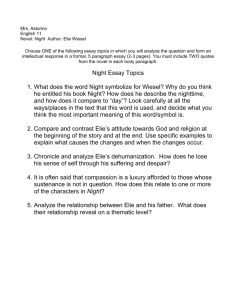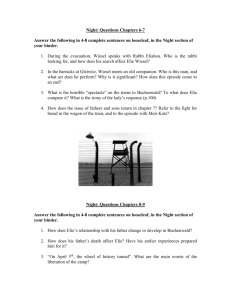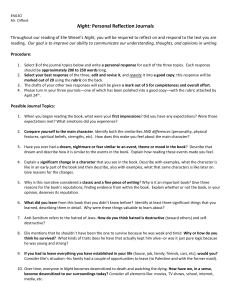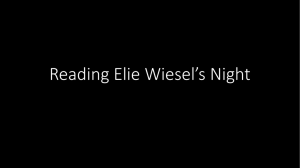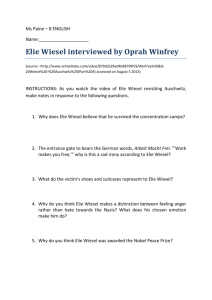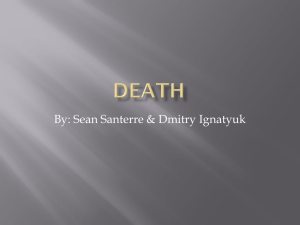Night by Elie Wiesel
advertisement
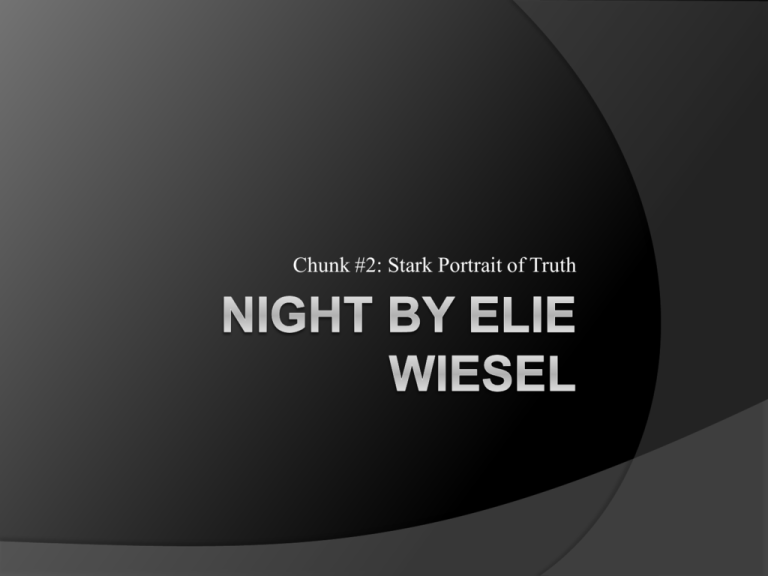
Chunk #2: Stark Portrait of Truth Chunk #2: Stark Portrait of Truth Day 1 Anchor Quotation: “You’re not supposed to be so blind with patriotism that you can’t face reality. Wrong is wrong, no matter who says it.” Malcolm X Night-Elie Wiesel Why should you not always believe what your eyes see? How does this still relate to appearance vs. reality? Chunk #2:Stark Portrait of Truth “Night” by Elie Wiesel EQs: Analyze stereotypes and scapegoats. Do forms of mass genocide exist today? What is our civic responsibility as Americans to intervene in other countries that are committing crimes against humanity? In what ways can individuals bring social awareness to such atrocities? To what extent do individuals have control over their lives? What role does chance, choice, or fate play? What are the causes and/or the rationale behind events such as the Holocaust or other instances of genocide? What is the importance of memory and remembrance in relation to genocide? How does Silence perpetuate violence? “Night” by Elie Wiesel Intolerance Inequality Human rights Dehumanization Survival Civil rights Relationships Genocide Faith Questioning Anti-Semitism Memory Social Awareness Responsibility Justice Loss of Innocence Write your reaction to the following statement: All young people are lazy and irresponsible. They can’t be trusted with anything serious or important. What does this have to do with the Holocaust? 1) How do you feel when you hear people say that all young people are irresponsible, uncaring, unintelligent, and/or lazy? 2) Do you think this attitude limits you as a young person? Does it affect how people treat you? 3) Where do people get their ideas about young people? How could we help change their ideas? What are the dangers of hatred and the resiliency of the human spirit? The novel Night by Elie Wiesel is unique in its perspective of the Holocaust. Wiesel recounts his actual experiences as a teenager suffering the extreme conditions in the concentration camps of World War II. Wiesel and his family endure both physical and emotional torture at the hands of Hitler’s officers in the death camps. In the end, Elie witnesses the death of his family, as well as the death of his innocence. Night Character List Eliezer (Elie): the narrator of Night. He is a Jewish boy of 12 at the end of 1941 and 15 when he enters the concentration camp. Chlomo: Elie’s father who is respected by the entire Jewish community and by his son as well. Moshe the Beadle: Elie’s teacher of Jewish mysticism. Akiba Drumer: A Jewish Holocaust victim who gradually loses his faith in God as a result of his experiences in the concentration camp. Night Character List Madame Schächter: A Jewish woman who is deported along with her ten-year-old son(Schächter) Juliek: A young musician whom Elie meets in Auschwitz. Tibi and Yosi: Two brothers with whom Elie becomes friendly in Buna. Dr. Josef Mengele: A cruel doctor who presides over the selection of arrivals at Auschwitz/Birkenau. Night Character List Idek: Elie’s Kapo at the electrical equipment warehouse in Buna. Franek: Eliezer’s cruel foreman at Buna. Rabbi Eliahou: A devout Jewish prisoner whose son abandons him in the march to Gleiwitz. Kapo: A prisoner who is assigned to supervise other prisoners and carry out administrative task in the camp Night Character List Zalman: Zalman is one of Elie’s fellow prisoners. Meir Katz: Meir Katz is Chlomo’s friend from Buna. Stein: Stein is Elie’s relative from Antwerp, Belgium, whom he and his father encounter in Auschwitz. Hilda: Hilda is Eliezer’s oldest sister. Béa: Béa is Eliezer’s middle sister. Tzipora: Tzipora is Eliezer’s youngest sister Write down the page number of examples as you find them in the book. THEMES SYMBOLS Silence Night Father/Son Fire Bonds Silence Maintaining Faith Inhumanity Self- Deception Day What events can suddenly change the course of a persons life? Read the UN Declaration on Human Rights (1948): http://www.amnestyusa.org/research/humanrights-basics/universal-declaration-ofhuman-rights List anything you see as odd or curious about the items enumerated here. Class Discussion Chunk #2:Stark Portrait of Truth “Night” by Elie Wiesel Define resilient How have you reacted when confronted with danger either to you or someone else? How can some be irrevocable changed by witnessing horrific events? Chunk #2:Stark Portrait of Truth “Night” by Elie Wiesel A. Read the Preface (Wiesel) and Chapter 1 of Night, and answer the following questions: Preface: 1. What conclusion does Wiesel draw about those who were silent before and during the Holocaust? 2. Why did Wiesel write this book? Chapter 1 (pp 3-22): 3. What is a beadle? 4. What is the Talmud? The Zohar? The Kabbalah? 5. What had Moishe the Beadle seen after his cattle train was taken over by the Gestapo? 6. Why do people not act when they hear dire warnings of impending disaster? 7. What is ironic about the behavior of the non-Jews who watch all of this take place? 8. Make a list of each step the Germans took to overthrow and imprison the Jews of Sighet (their targets) with so little resistance. (Commit this to memory and never forget it.) Chunk #2:Stark Portrait of Truth “Night” by Elie Wiesel Read Chapter 2 (pp 23-29) and answer the following questions: 1. Why do the Germans demand all of the Jews’ valuables? 2. How do you think Mrs. Schachter could foresee the fire burning at Birkenau, their eventual destination? Chunk #2:Stark Portrait of Truth “Night” by Elie Wiesel Read Chapter 3 (pp 29-46) and answer the following questions: 4. Along with their possessions, the Jews could no longer keep their illusions about what was happening (29). How can you tell if you have illusions, and how can you know what they are? 5. Why does the veteran prisoner tell Elie and his father to lie about their ages and professions? 6. What literary device does Wiesel use when he mentions the “silent sky” (34)? What does he mean? 7. What are the two options each prisoner has at Auschwitz? 8. What is A-7713? 9. Why does Stein insist that Elie and his father eat all they can? What if they don’t? 10. Who is Job, with whom Elie agrees concerning the justice of God (45)? What had Job endured? Chunk #2:Stark Portrait of Truth “Night” by Elie Wiesel Read the article at this address, and make notes in your notebook: http://academics.wellesley.edu/Polisci/wj/10 0/mengle.htm Be ready to take a quiz over this article. Chunk #2:Stark Portrait of Truth “Night” by Elie Wiesel Read Chapter 4 (pp 47-65) 1. Why were the younger boys in Elie's block fed well? 2. "It was good to have a Jew as your leader" (51). What is Wiesel saying about Jews in general? Why might they be good leaders? 3. What does the German government's focus on the jewelry and gold fillings of the Jews tell you about the priorities of its leadership? 4. What, in your opinion, are some foci (plural of focus) of the American government today, based on its actions? 5. What does the story about the two cauldrons of soup demonstrate about the state of mind of the prisoners? 6. How do falling bombs make Elie and his fellow prisoners hopeful and happy? 7. What is the effect of the young boy's hanging on the other prisoners? Chunk #2:Stark Portrait of Truth “Night” by Elie Wiesel Read Chapter 4 (pp 47-65) 1. Why were the younger boys in Elie's block fed well? 2. "It was good to have a Jew as your leader" (51). What is Wiesel saying about Jews in general? Why might they be good leaders? 3. What does the German government's focus on the jewelry and gold fillings of the Jews tell you about the priorities of its leadership? 4. What, in your opinion, are some foci (plural of focus) of the American government today, based on its actions? 5. What does the story about the two cauldrons of soup demonstrate about the state of mind of the prisoners? 6. How do falling bombs make Elie and his fellow prisoners hopeful and happy? 7. What is the effect of the young boy's hanging on the other prisoners? Chunk #2:Stark Portrait of Truth “Night” by Elie Wiesel CH. 6-7 Read Chapter 6 (pp 85-97) 1. What action caused the Buna evacuees to be shot by the SS? 2. How far had the prisoners run overnight? How many miles does this equate to? 3. What had Rabbi Eliahu's son done, and why? What is Elie's reaction to this action? 4. What almost kills Elie when they arrive in Gleiwitz? 5. Why is Juliek playing Beethoven? Why had the Nazis forbidden Beethoven's music? 6. How does Elie save his father's life? How are the interlocking oppressions of race, class, and gender at work in the lives of the characters? Chunk #2:Stark Portrait of Truth “Night” by Elie WieselCH. 6-7 Chapter 7 (pp 98-103) 7. How does Elie save his father's life again? 8. What causes a stampede on the cattle cars? 9. Who dies as a result of the stampede? 10. What is Elie's father's name? 11. What percentage of the men on Elie's cattle car had survived the ride to Buchenwald? Chunk #2:Stark Portrait of Truth “Night” by Elie Wiesel Chapter 7 (pp 98-103) 7. How does Elie save his father's life again? 8. What causes a stampede on the cattle cars? 9. Who dies as a result of the stampede? 10. What is Elie's father's name? 11. What percentage of the men on Elie's cattle car had survived the ride to Buchenwald? Chunk #2:Stark Portrait of Truth “Night” by Elie Wiesel Nobel Peace Prize acceptance speech (pp 117-120) 8. On whose behalf does Elie accept the Nobel Peace Prize? 9. What does he call those who forget the Holocaust? 10. "Neutrality helps the __________, never the victim." EQ: Analyze how Wiesel uses rhetorical 11. Who is Andrei Sakharov? devices to convince his hearers to act. 12. Who is Joseph Begun? 13. Who is Lech Walesa? 14. "__________ is the only nation in the whole world whose existence is threatened." 15. "Our lives no longer belong to us alone; they belong to all those who ___ ___ ________." Chunk #2:Stark Portrait of Truth “Night” by Elie Wiesel EQ: Analyze how Wiesel uses rhetorical devices to convince his hearers to act. Reread Elie Wiesel's Nobel Peace Prize speech at the back of the novel. On your own paper, identify examples of the following rhetorical devices. Leave yourself some room, putting A through D on the front of your paper and E through H on the back: a. logos (a logical appeal) b. ethos (an ethical appeal) c. pathos (an emotional appeal) d. rhetorical question (asking a questions the answer to which is obvious) e. repetition (using the same words to emphasize a point) f. restatement (saying things in different ways to illustrate a point) g. chargeds words (words that are heavy with emotional connotations) h. parallel structure (repeating grammatical patterns to emphasize a point) Setting: A Major Effect on Tone Setting can be used to create a specific tone for a story. The author, Elie Wiesel, uses setting to set a tone of depravity as well as horror and despair. Using carefully chosen words enhances the emotional impact you want your writing to have. Creating vivid images of a setting can evoke particular emotions in the reader. Directions: After reading Section 4, circle the words in each quotation that contribute to the tone underlined after the phrase. Note that two of the tone words have been left blank for you to fill in. 1. “The camp looked as though it had suffered an epidemic: empty and dead.” Tone: Desolation 2. “I dragged myself to my corner. I ached all over. I felt a cool hand wiping my blood- stained forehead. It was the French girl. She gave me her mournful smile and slipped a bit of bread into my hand.” Tone: ________________________ Setting: A Major Effect on Tone 3. “Suddenly...a man appeared crawling, like a worm in the direction of the cauldrons. Hundreds of eyes followed his movements. Hundreds of men crawled with him, scraping their knees with his on the gravel. Every heart trembled, but with envy above all. This man had dared.” Tone: Depravity 4. “But his (Oberkapo) little servant had been left behind in the camp in prison. Also put to torture, he too would not speak. Then the SS sentenced him to death, with two other prisoners who had been discovered with arms...all eyes were on the child. He was lividly pale, almost calm, biting his lips. The gallows threw its shadow over him...For more than half an hour he stayed there, struggling between life and death, dying in slow agony under our eyes...Behind me, I heard the same man asking: ‘Where is God now?’ And I heard a voice within me answer him: ‘Where is He? Here He is — He is hanging here on this gallows...’ ” Tone: ________________________ Irony at Work Irony is a literary device that shows a contrast between appearance and reality, expectation and result, or meaning and intention. In verbal irony, words are purposefully used to suggest the opposite in meaning. In dramatic irony, there is a difference between what the character thinks and what the reader or audience knows. In situational irony, an event occurs that is the opposite of what is expected. Directions: Determine whether the passages below are examples of verbal, dramatic, or situational irony. 1. “I did not weep, and it pained me that I could not weep. But I had no more tears. And, in the depths of my being, in the recesses of my weakened conscience, could I have searched it, I might perhaps have found something like — free at last!” Type of irony: Irony at Work 2. “Saturday, the day of rest, was chosen for our expulsion.” Type of irony: 3. “The Germans were already in the town, the Fascists were already in power, the verdict had already been pronounced, yet the Jews of Sighet continued to smile.” Type of irony: 4. “We would be getting out here. There was a labor camp. Conditions were good. Families would not be split up. Only the young people would go to work in the factories. The old men and invalids would be kept occupied in the fields. The barometer of confidence soared. Here was a sudden release from the terrors of the previous nights. We gave thanks to God.” Type of irony: Themes Revisited Now that you have finished the novel, what messages do you believe the author wants you to understand? Directions: Write a thematic statement for each of the examples given below. 1. “After my father’s death, nothing could touch me anymore.” “But for the moment I was happy; I was near my father.” “Were there still miracles on this earth? He was alive. He had escaped the second selection.” Theme: 2. “I was a body. Perhaps less than that even: a starved stomach.” “And I had but one desire — to eat.” “A piece fell into our wagon. I decided that I would not move. Anyway, I knew that I would never have the strength to fight with a dozen savage men!” Theme: 3. “Meir, Meir, my boy! Don’t you recognize me? I’m your father...you’re hurting me...you’re killing your father! I’ve got some bread...for you too...for you too....” “His son had seen him losing ground, limping, staggering back to the rear of the column...He had continued to run on in front, letting the distance between them grow greater.” “My God, Lord of the Universe, give me strength never to do what Rabbi Eliahou’s son has done.” Theme: Found Poems” about Elie Wiesel’s Book Night After reading the book by Elie Wiesel in which he wrote about experiencing the Holocaust, students wrote “Found Poems.” The students selected words and phrases from different pages of the book and put them together in their own order to write the poems below. http://silverinternational.mbhs.edu/v212.2/v21-2-04afoundpoems.html
